|
Comets are small bodies made out of dust and ices ("dirty snowballs").
The term "comet" derives from the Greek aster kometes, which means
"long-haired star"---a reference to the tail. The following images show three
recent bright comets: Comet West
(Ref), Comet Hyakutake
(Ref), and Comet Halley
(Ref).
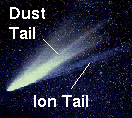
Comet West (1976) |

Comet Hyakutake (1996) |
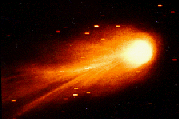
Comet Halley (1984) |
The Nature of Comets
Once thought to be phenomena in our atmosphere, we have known since the observations
of Tycho Brahe that they are parts of the Solar System well beyond Earth's
atmosphere. Most are on long elliptical orbits (perhaps parabolic in some cases)
that take them from the outer reaches of the Solar System to the vicinity of the Sun. If they
come near the Sun they are heated and emit gases and dust that are swept by the
Solar Wind into the characteristic tail that consequently always points away from the Sun.
Observation of Comets
Historically, comets have been the subject of fear and foreboding because it was once thought that
their appearance foretold momentous events. Although a dozen or so comets pass
through the inner Solar System each year, comets easily visible to the naked
eye occur only every decade of so, on the average.
Comets are commonly named after their discoverers, so they are a popular target of amateur and professional
observers. The characteristics that distinguish comets observationally are
that they move (slowly) with respect to the background stars from night to
night, and they have a fuzzy appearance, especially as they near the Sun.
General Properties
As we have noted in the introduction, the most concise description of comets is
that they are dirty snowballs. They are a few kilometers
across, and appear to mostly be composed of water, carbon dioxide, ammonia, and
methane ices, with dust mixed in. We believe that this composition represents a sampling of
primordial material from which the Solar System was made.
Therefore, they are of considerable scientific interest for the information
that they may carry concerning the early history of the Solar System.
Cometary Orbits
Comets interact gravitationally with the Sun (and other objects in the Solar System).
Their motion is also influenced to some degree by gases jetting out
of them, so their orbits are primarily but not completely determined by gravity.
Here is an image showing
7 such jets from
Hale-Bopp, a recently-discovered, long-period
comet that was very bright comet in the Spring of 1997.
Most cometary orbits appear to be elliptical, or in some cases
parabolic. The most common comets belong to a population called the
short-period comets that have only mildly elliptical orbits that carry
them out to a region lying from Jupiter to beyond the orbit of Neptune.
A dozen or so of these comets pass through the inner Solar System each year, but they usually are only seen in telescopes.
The comets that are more likely to be easily visible are much rarer, and are
thought to come from a great spherical cloud of cometary material surrounding
the Solar System called the Oort Cloud. This sphere is a
light year (50,000 A. U.) in radius, so it is enormous, but the total mass of
cometary material in this cloud is probably less than that of the Earth.
Occasionally a comet in this cloud is disturbed gravitationally, for example by
a passing star, and started on a long elliptical or parabolic orbit toward the
Sun. These long-period comets are primarily responsible for the
brighter comets observed historically. The orbits of both the long-period and
short-period comets may be strongly influenced if they pass near the Jovian planets, particularly Jupiter itself.
Plotting Your Own Orbits
You may make real-time plots of the orbits and present positions of comets (and other objects in the Solar System) using the Web-based
Solar System Live software. To plot the orbits of comets
and asteroids, you must supply the orbital elements of the object in question.
Help pages
associated with Solar System Live explain how to obtain these.
The Head and Coma
The Tail
 The tails of bright comets can be 150 million kilometers
(1 A.U.) in length, making them the "largest" objects in the Solar System.
However, the tail is composed of gas and dust emitted from the nucleus and is
very diffuse. The vacuum in the tail is much better than any vacuum we can produce on Earth.
The tails of bright comets can be 150 million kilometers
(1 A.U.) in length, making them the "largest" objects in the Solar System.
However, the tail is composed of gas and dust emitted from the nucleus and is
very diffuse. The vacuum in the tail is much better than any vacuum we can produce on Earth.
Many comets have two tails, a gas tail (also called
the ion tail) composed of ions blown out of the comet away from the Sun by
the solar wind, and a dust tail composed of dust particles liberated
from the nucleus as the ices are vaporized. The dust particles are left behind
in the comet's orbit, and blown slightly away from the Sun by the pressure of the light from the Sun.
Thus, they tend to curve relative to the straight ion tail. The ion tail often
shows structure associated with variations in the ejection rate from the nucleus over time.
The adjacent image of Comet West (1976) illustrates distinct ion and dust tails
(Ref). As seen in this example, the ion tail and the dust tail usually have different
appearances. The ion tail is typically bluer in color, narrow, and straight; the dust tail is more
diffuse, often looks curved, and is more white in color. These differences in appearance are directly correlated
with the different sources and compositions of the two tails.
Comet Hyakutabke
 |
Comet Hyakutake, shown in the left figure from 1996
(Ref),
was one of the brightest comets in recent years.
The image at the right shows a Hubble Space Telescope image of the nuclear region
(more info).
The entire image is 760 km across; the bright spot at the very center is
thought to be a jet of material, with the nucleus lying obscured under this bright spot. |
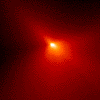 |
Here is a more extensive discussion of the Hubble Space Telescope
observations of Hyakutake, and here are the
orbit and present position of Hyakutake.
Finally, here is a link to some
movies (AVI and QuickTime format) of Hyakutake.
Comet Hale-Bopp
Hale-Bopp is a long-period comet that was discovered in 1995 and
that reached perihelion in Spring, 1997. Because it was much brighter
than comets normally are when it was first discovered outside the
orbit of Jupiter, there was considerable speculation that in the Spring of 1997 Hale-Bopp would be a spectacular sight.
But Comet Brightness is Notoriously Unpredictable
On the other hand, comets that are predicted to be very bright when discovered often do not live up to their advanced billing
(here is an associated
funny story concerning the
comet Kohoutek; a comet that never grew as bright as predicted in 1974).
Hale-Bopp did turn out to be a spectacular sight, certainly one of the better comets of recent years.
Here is the
path on the celestial sphere of the comet in 1996 and 1997.
The Orbit of Hale-Bopp
The orbit of Hale-Bopp and its position with respect to the planets
of the inner solar system on Dec. 16, 1996, is shown in the following figure.
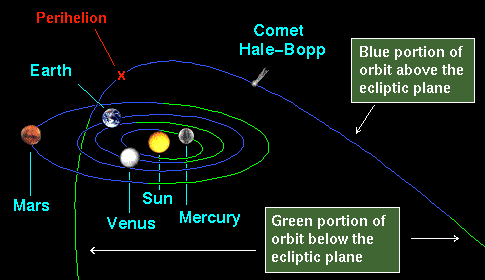 |
Comet Hale-Bopp, December 16, 1996 |
In this image the orbits are drawn to scale, but the sizes of the planet and comet images (and the length and orientation
of the comet tail) are not realistic.
At this time the comet was about 2 A.U. from the Sun and about 2.7 A.U. from the Earth. The
color blue indicates portions of orbits that are above the plane of the
ecliptic and green indicates portions of orbits that are below the plane of the ecliptic. Notice that
Hale-Bopp has an orbit that is either parabolic or highly elliptical, and that
its orbit is very far out of the plane of the ecliptic.

The Inner Solar System on April 1, 1997, with Comet Hale-Bopp at perihelion. |
Comet Hale-Bopp reached perihelion on April 1, 1997, at a
distance of 0.91 A.U. from the Sun and 1.36 A.U. from the Earth.
The image on the left shows the relative positions of objects in the inner solar system
on that date. Here is the
present position of Comet Hale-Bopp. |
Telescopic Observations of Hale-Bopp
The following figure shows the temporal evolution of Comet Hale-Bopp
from late 1995 through late 1996, as observed by the Hubble Space Telescope.
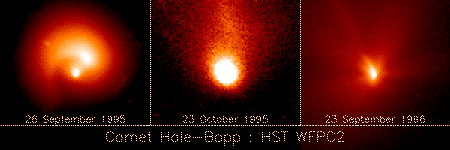 |
| Hubble Space Telescope Images of Comet Hale-Bopp (1995) |
The left frame shows the comet about 60 hours after a huge outburst of dust; it shows a spiral structure
reminescent of a water sprinkler observed from above. The middle frame shows the comet during a more quiescent phase.
The right figure shows a more recent image with at least five jets emanating from the nucleus.
(Here is an enhanced photograph of at least
7 jets from Hale-Bopp taken at the
European Southern Observatory.)
The nucleus of the comet is located at the center of each frame, but most of the
light observed is caused by scattered sunlight from the coma of dust emitted from the nucleus.
Comet Halley
The best known comet of all is Halley, which has returned with a 74-79
year period since 240 B.C. The following image
(Ref)
shows a famous view of the full tail of Halley recorded from the Mount Wilson Observatory.

Comet Halley from Mount Wilson |
Edmund Halley and His Comet
 The English astronomer
Edmund Halley
was a good friend of Isaac Newton. In 1705 he used Newton's new theory of
gravitation to determine the orbits of comets from their recorded positions in
the sky as a function of time. He found that the bright comets of 1531, 1607,
and 1682 had almost the same orbits, and when he accounted for the
gravitational perturbation on the cometary orbits from Jupiter and Saturn, he concluded
that these were different appearances of the same comet. He then used his gravitational calculations to predict
the return of this comet in 1758.
The English astronomer
Edmund Halley
was a good friend of Isaac Newton. In 1705 he used Newton's new theory of
gravitation to determine the orbits of comets from their recorded positions in
the sky as a function of time. He found that the bright comets of 1531, 1607,
and 1682 had almost the same orbits, and when he accounted for the
gravitational perturbation on the cometary orbits from Jupiter and Saturn, he concluded
that these were different appearances of the same comet. He then used his gravitational calculations to predict
the return of this comet in 1758.
|
A Posthumous Christmas Present
Halley did not live to see his prediction tested
because he died in 1742. But on Christmas night, 1758, the comet destined everafter to bear Halley's name
reappeared in a spectacular vindication of his bold conjecture and of Newton's gravitational
theory. Tracing back in the historical records for recordings of bright comets
and their positions in the sky, it was concluded that Halley
had been observed periodically as far back as 240 B.C. The most recent return was in
1986, and the predicted next appearance of Halley in the inner Solar System will be in 2061. |
|
The Orbit of Halley's Comet
The following figure shows the orbit of Halley's Comet and its predicted
location in 2024 relative to the orbits of the planets.
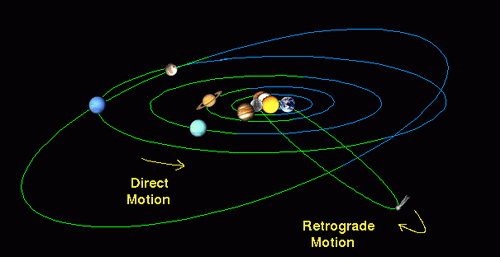
Halley's Comet in 2024 |
Blue is above the plane of the ecliptic and green is below. Almost the entire Halley orbit is below the plane
of the ecliptic. Further, Halley revolves around its orbit in retrograde
motion (the opposite sense from planet revolution). In the preceding view the
planets revolve counter-clockwise and Halley revolves clockwise.
The following image shows the same thing, but from a top view.

Halley's Comet in 2024---Top View |
Notice that Halley's orbit extends essentially to the distance of Pluto, but when Halley is at its
greatest distance from the Sun (aphelion)
it is below the plane of the ecliptic (green color) while that portion of
Pluto's orbit is above the plane of the ecliptic (blue color).
The following image illustrates this more clearly. It is a view
of the orbit of Halley and its 1996 position from the vantage of the ecliptic plane:
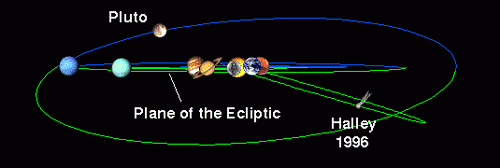
Solar System View from the Ecliptic Plane |
This view illustrates clearly four important features of our Solar System:
- How close to a plane the orbits of all planets but Pluto lie.
- The large tilt of Pluto's orbit out of the ecliptic plane.
- How elliptical Comet Halley's orbit is.
- How Halley's orbit lies well below the plane of the ecliptic when it is in the outer Solar System.
Here is the
present position of Halley's Comet (top view of Solar System), and here is the
present position (side view of Solar System).
Collisions of Comets with other Bodies
Since the orbits of comets sometimes cross the orbits of other bodies in the
Solar System, collisions may occur. At one time it was thought that a
collision of a comet with the Earth would not be a serious matter. We now
believe differently. In fact, there is rather strong evidence that the Earth was struck by a comet or small asteroid
early in this century, with devastating results.
The Tunguska Event
On the morning of June 30, 1908, in a remote region of central
Siberia, a great blue-white fireball brighter than
the Sun streaked through the sky and exploded while still in the air with a
blinding flash and intense pulse of heat. The explosion was heard 1000 km
away, and it flattened trees radially 30 kilometers out from a central point in
the Stony Tunguska River valley. The resulting pulse of air pressure
circled the Earth twice, and astronomers observed for several nights
afterwards a glowing red haze in the upper atmosphere, though they were not
aware at the time of the cause.
It is estimated that the explosion had the force of a 10-20
megaton hydrogen bomb and detonated in the atmosphere about 6-8 km above the surface,
which would explain why no crater has ever been found.
The region was so remote that there were few witnesses and presumably
little loss of life. As a result, news of the event filtered only slowly to the outside world. Because of the
remoteness and the political turmoil of the early part of this century, it was
only 1927 when a scientific expedition finally went to investigate the event.
Though various fantastic theories have been proposed (the crash of an alien
spaceship), the simplest explanation that is consistent with all the data is
that the Earth was struck by the head of a small comet or a small rocky asteroid maybe 100 meters in
diameter that exploded before striking the ground.
Comet Shoemaker-Levy 9 Encounters Jupiter
We now have direct observations of a cometary impact on another body in the Solar
System. In July of 1994, fragments of
Comet Shoemaker-Levy 9impacted the planet Jupiter. The points of impact were not directly visible from Earth but
could be observed by the Galileo spacecraft, and the impact regions were
quickly brought into Earth view by the rapid rotation of Jupiter.
The Orbit of Shoemaker-Levy 9
Shoemaker-Levy 9 was a comet with a somewhat elliptical
orbit that partially intersected that of
Jupiter, and went nearly as far out as the orbit of Saturn. The following
sequence of images shows the orbit of Shoemaker-Levy 9 and its location
relative to Jupiter in 1990, 1992, and 1994 (when it collided with the giant
planet). The final image shows what would
be the present location of Shoemaker-Levy 9 had it not impacted Jupiter in 1994.
- Shoemaker-Levy 9 on
July 16, 1990.
- Shoemaker-Levy 9 on
July 16, 1992.
- Shoemaker-Levy 9 on
July 16, 1994
(fragments begin to strike Jupiter).
- Where Shoemaker-Levy 9 would be
today, if it had not collided with Jupiter.
The Impact of Fragments from Shoemaker-Levy 9
Here is an animation illustrating
Shoemaker-Levy fragments
colliding with Jupiter.
The following 4 images were taken by the Galileo spacecraft of the
impact of fragment W from the ill-fated Comet Shoemaker-Levy 9.
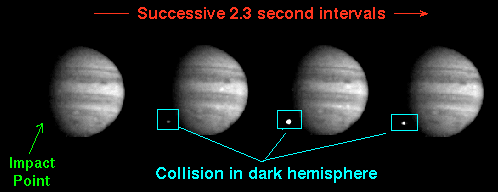
Galileo images: Fragment W of Comet Shoemaker-Levy 9 Strikes Jupiter |
These four images were taken at intervals of 2 1/3 seconds on July 22, 1994, with Galileo at a
range of 238 million kilometers. The first image shows no impact. In the
next three images, a point of light appears, brightens,
and then fades, seven seconds after the first picture.
Only Galileo was able to directly see the impact sites; from the Earth, the collision site
was on Jupiter's back side.
It is believed that the point of light in this picture shows the
effects of the comet fragment entering Jupiter's
atmosphere and is not related to the subsequent explosion and fireball
(Ref).
The following images are Earth-based observations of the impact sites after
they have rotated into view from the Earth.
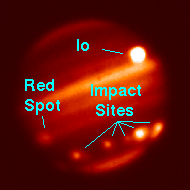
IR from Mauna Kea |
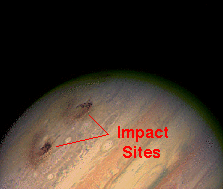
Visible Wavelengths from Hubble |
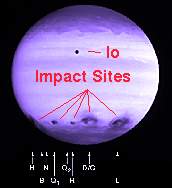
UV from Hubble |
The left image
(Ref) is taken from the NASA Infrared
Telescope Facility, Mauna Kea, Hawaii.
The impact due to Fragment Q is to the far right and
the R Fragment impact site
shows up very brightly to its left.
Additional impact sites form a chain of spots
behind R
(more info).
The middle figure
(Ref) shows a Hubble Space Telescope
color image of the impact sites for fragments G and Q2.
The right figure
(Ref) shows
an ultraviolet image of Jupiter taken by the Wide Field Camera of
NASA's Hubble Space Telescope.
The spots are very dark
in the ultraviolet because a large quantity of dust is being deposited
high in Jupiter's stratosphere and the dust absorbs sunlight
(more info).
Small Water Comets?
A
controversial theory that the Earth is being bombarded constantly by
comet-like objects the size of small houses and consisting mostly of water has
received support from recent satellite
observations.
Cosmic Snowball Tracks?
In the image shown below the suspected track of such a cosmic snowball is captured by the
visible imaging system of the
Polar Satellite
as the object vaporized at an altitude of 5,000 to 15,000 miles over the Atlantic Ocean
and Western Europe in September, 1996.
Observations indicate that these objects are vaporizing and leaving behind clouds in
the atmosphere that are 10-100 kilometers across and have high concentrations of water vapor.
This interpretation was first suggested in the mid-1980s from the UV satellite observation of
dark spots in the "dayglow"
(ultraviolet light produced by sunlight interacting with oxygen in the
atmosphere). Large clouds of water vapor would absorb the UV light at the
frequencies that the satellite was observing, thus leaving a dark spot or "hole" in the dayglow.
Implications for History of Atmosphere and Oceans
If such a bombardment has continued for long periods, it would have enormous implications for
our understanding of the origin and evolution of the Earth's atmosphere and
oceans, and perhaps for the evolution of life itself on the planet. For
example, the present estimated rate of this bombardment is of order 10 per
minute, with each event believed to deposit 20-40 tons (!) of water vapor in the upper atmosphere.
This influx would add approximately 1 inch of water to the surface of the Earth every 20,000 years.
If an appreciable fraction of this rate has been sustained over the 4.5 billion year history of
the planet, such small comets might be responsible for all the
water in the oceans and in our atmosphere. Furthermore, there may might be
compounds other than water in the bombardment, which could have important
implications for various geochemical and biological cycles.
This would imply a rather different scenario than the
traditional one that our
atmosphere and oceans were formed by gases emitted from the crust of the Earth after its formation. Here is an
FAQ (list of frequently asked questions) composed by proponents on this developing and still controversialtopic.
| 

